|
Shortly after WWII, the government
sold the Airacobras it didn't need. The ad read: "$100-complete ready to fly." (Read
it and weep!). I still clearly recall reading that line back in the original publication
of the September 1973 edition of AAM, and thinking how nice it would have been to
be able to buy one. Not many people must done so, though, because restored P-39s
are almost never seen at airshows or in flying magazines. The complete article and
4-view illustration by Bjorn Karlstrom has been scanned and posted here.
Airacobra
The engine-in-back fighter, aerodynamically very clean, but way too heavy for
a fighter, made one heck of a ground-attack machine.
by Patricia T. Groves and Bjorn Karlstrom
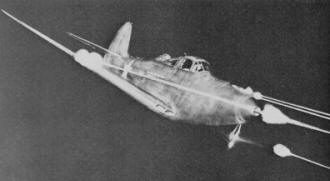
Doing her thing best during a night firing session, the 'cobra
put out tremendous fire-power, including the cannon in the spinner.
In February 1937 the 19-month-old Bell Aircraft Corporation entered two designs
into competition for an Army pursuit plane. Thinking in terms of "new weapon," both
designs were built around a 37 mm cannon located in the nose and fired through the
propeller hub. Both designs featured novel (for the day) tricycle landing gear.
In one design, the pilot sat conventionally behind an Allison liquid-cooled engine,
while in the other - unconventionally forward1 The Army found the latter
design more appealing, and so on May 18, 1937 the company submitted a formal proposal.
While waiting for the necessary red tape to unravel into a development contract
(issued October 7, 1937), Chief Designer Bob Woods continued engineering while preliminary
construction began on the prototype. With retractable gear neatly tucked in, the
design showed an exceptionally clean-lined aircraft throughout fuselage and wings.
On the ground, the tricycle gear would provide greater ground-handling ease. In
the air, unorthodox placement of the super-charged engine amidships, among other
things, promised greater visibility for the pilot. It was named Airacobra, and aptly
so, for with in its thin and wartless nose lurked a deadly fang.
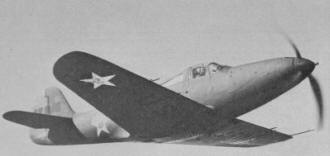
Its clean shape, all its weight at the CG, a door with roll-up
window and a drive shaft right through the cockpit were memorable features. Best
defensive maneuver? Point it straight at the ground and bug out.
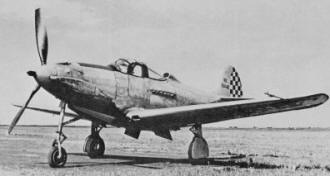
The prototype rolled out of the Buffalo hangar-a lovely sight to behold. Sitting
there in all its spraddle-legged beauty, it was 28' 8" from slender nose to tail
and 35' 10" from wing tip to wing tip. Weighing a smidgen less than 4000 lb. (prototype
without self-sealing tanks or ordnance), its smooth and flawless skin was unmarred
by protruding rivet heads. An innovative cabin sported automobile-type doors with
roll-down windows.
With all possible weight placed over the CG, the prototype promised high maneuverability,
speed and handling ease. Engineering had been a bear but, when completed, the 1150-hp,
Prestone-cooled, turbo-supercharged Allison V-1710-17 engine, its extended drive
shaft, reduction gear/gear box housing wound up all solidly aligned within a hell-for-stout
chassis. Tested April 6, 1938, subsequent tests of the now designated XP-39 brought
maximum speeds up to the era's "magic 400" (mph) mark. Following Army inspection
and trials at Dayton, a follow-on contract for 13 Service Test models was issued
on April 27, 19392.
Shortly after WWII, the government sold the Airacobras it didn't need. The ad
read: "$100-complete ready to fly." (Read it and weep!) Too bad there aren't too
many left - unless Russia still has thousands left parked somewhere.
By now the political situation in Europe was deteriorating rapidly, and Bell
vice-president Harry Collins made a quick sales trip across the Atlantic. He returned
home with a solid order from France for 200 Airacobras, which, within a short time,
was followed by a procurement order from the U.S. Army for 80 additional airplanes3
Both orders were more or less processed together.
Meanwhile, back at the Engineering Office, Bob Woods and his men were beginning
to look a little distraught around the eyes. After subsequent study of the XP-39,
and at the suggestion of NACA, the Army began issuing "recommended changes." By
the time the first 80 military models rolled off the assembly line, alterations
to the original design had been such that the airplane was designated P-45. However,
between Point X and Point Y some typically firm U.S. military decisions were made
and, of the 80 P-45s, 20 popped off the line as P-39Cs~ while the other 60 emerged
as P-39Ds4.
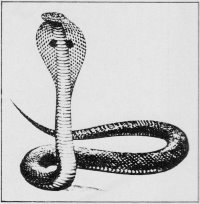
At this juncture the turbo-supercharger was long gone. What with various engine
changes, a little chopping here, a little pasting there, the addition of its ordnance
and protective armor, the sleek 'cobra had lost its svelte qualities. Not only that,
but the high wing loading plus all the lard altered her original flying characteristics.
The fully-militarized P-39D had leak-proof fuel tanks, four .30 caliber guns
in the wings, two .50 caliber guns and a 37 mm cannon in the nose. Under the fuselage
there was provision to carry either a bomb or a jettisonable fuel tank5.
From a pilot's point of view, except for the 20 mm cannon replacing the 37 mm cannon,
the export Airacobras weren't appreciably different from the U.S. military models.
About the time the export order was nearing completion, France changed hands,
so the British took over the order. But after a trial period, British airmen turned
thumbs down on the American airplanes. They cancelled the unfilled portion of the
order and - like Aunt Minnie's Christmas tie - donated the remaining white elephants
to the needy. In this case, the USSR.
Well -- give a Russian a lemon and he'll make lemonade. They fell in love with
the Airacobra. Not with any great passion, you understand. It's just that they quickly
optimized on its capabilities.
With the enemy virtually pounding on the Kremlin door, Russia's Air Force applied
battle experience learned during the Spanish Civil War and from clashes with the
Japanese on the Siberian border. Since fighting along the German Soviet Front was
done at roughly 3500 to 10,000 ft., those dear little Cobrastochkas functioned at
their attacking best6.
By now the U.S. was falling under the gun, and so the undelivered portion of
the British order was picked up on USAAF inventory as P-400s7. Seventy-five
of these airplanes were syphoned off for delivery to American units in the Philippines8.
But Pearl Harbor intervened, and the weeks immediately following became a seemingly
helter-skelter dash to regroup in the face of rapid Japanese advances. As initial
groups of routed Americans straggled into the relative safety of Java and Australia,
American Command and Logistics sought to get established in the southern Australian
port of Sydney.
This was a period when Americans were new at war. This was a period when "learning
the trade" would be costly, since so much had to be unlearned in the process.
For one thing, American fighter pilots, trained in WW I tactics of the whirling,
swirling dogfight, found out that they couldn't mix it up at Japanese altitudes
and hope to come out whole. The Japanese inventory outclassed the P-40s, P-35s and
P-26s then on hand in the Pacific arena.
Among the early cargoes into Sydney was the shipment of 75 Bell P-400s which
had been diverted along the way. And, at about that same time, three "orphaned"
American fighter squadrons also arrived from the U.S. Except for one qualified squadron
commander in each, they arrived short of everything but trainee-grade personnel.
These three random squadrons were assigned to a recently formed (albeit squadronless)
Headquarters Squadron composed of battle-experienced pilots. This thrown-together
unit, under Col. Richard Legg, formed the nucleus of what would later become the
35th Fighter Group.
Initially the unit acquired a quantity of the Airacobra still in their British
markings. And, if there was any kind of a cloud hanging over them, it hadn't reached
Sydney. To the pilots the Airacobras were vitally needed new equipment. Checkout
and training missions began immediately.
After an unsuccessful period of using the aircraft defensively in fighter-to-fighter
combat, it was found to be better suited for offense-in a bombing, strafing, ground
attack roll. Except for heavy flak fired from the ground or a direct on the coolant,
the vulnerable areas were well protected with the pilot virtually encased in a box
of armor. And when the enemy came around to protest, 'cobra pilots at 'cobra altitudes
faired better.
Compared to tail draggers, the Airacobra's tricycle gear gave it a sports car
quality that got it to the end of the runway and up and out in a hurry. When the
Japanese were overhead, since the place to be was in the air (or in a foxhole) and
not somewhere in between, the jungle-bordered runways often seemed like the South
Pacific version of Le Mans.
There were shortcomings in the aircraft that either an overall change in circumstance
or a later model seemed to cure. Because the geographic situation in the Pacific
required long missions, the pilots weren't inclined to dillydally over the target.
And by the time they returned to their home bases, they were tired and worn out.
In early model 'cobras there was a disastrous side-by-side placement of landing
gear and flap switches, identical in shape, on the left side of the panel. And those
pilots inclined toward a short nap while in the landing pattern were likely to have
a rude awakening. But, even so, a rotten landing still brought the pilot out alright.
Ordnance on the early P-39s was classed as "a pain," because it was so mixed-a
combination of either the 20 or 37 mm cannon and 30 and 50 caliber machine guns.
This diversity of firepower made it difficult for the armorer to maintain. (In later
models this mixture of ordnance was reduced to the use of the 37 mm and 50 caliber
sizes.)
However, there was a difficulty with the 37 mm that doesn't seem to have been
present with the 20 mm cannon. If it was fired just as the plane entered a zero
G condition, the spent shell casing floated in the breech, and the pilot then had
a jammed gun he couldn't reach to clear. But in general, the cannon-through-the-hub
was well received. Properly bore-sighted, it was considered accurate enough to "hammer
a nail."
While inherent idiosyncrasies of the Airacobra may have made it less than welcome
by those in the European theatre of operations, nevertheless in that theatre it
had the lowest loss rate per sortie percentage (.04%) than other American fighter
airplanes.9 When used in its proper roll as a weapon of attack, the Airacobra found
its niche in war. And, when the National Air Races again became a peacetime "happening,"
some mighty surprised "also-rans" also learned that an old 'cobra bites twice.
Footnotes
1 Maxine Block, Current Biography 1941 (New York, H.W. Wilson Co., 1942).
2 Ray Wagner, American Combat Planes (New York, Hanover House, 1960), p. 219.
3 Rendezvous, IX, 1 (Buffalo, The Bell Aerospace Co., 1970), p. 4.
4 James C. Fahey, Ed., U.S. Army Aircraft 1908-1946 (New York, Ships and Aircraft,
1946), p. 33.
5 For details on variants, see Jay Frank Dial, The Bell P-39 Airacobra (England,
Profile Pubs., Ltd., 1971).
6 "Blasting to Berlin," Bell Aerospace News Release (undated). (Letters of commendation
to company employees by officers of USSR Air Force.) The Russian
Airacobras were operational beginning June 29,1942.
7 F. G. Swanborough, United States Military Airlift Since 1909 (London, Putnam &
Co., Ltd., 1963), p. 19. "The Bell Airacobras ordered by Britain
were structurally similar to the U.S. Army P-39s, but were otherwise
so different that they could not be integrated into the Air Corps maintenance and
supply systems as P-39s. Consequently, the requisitioned examples were identified
by the letter "P" to identify them as pursuit types. Further deviation
from normal procedure was reflected by the fact that all aircraft
requisitioned from British direct-purchase contracts were flown with their original
British serial numbers and were not given regular Army Air Corps serials."
8 W.A. Sheppard, Col. USAF (Ret). At the onset of WWII he was a Lieutenant and
fighter pilot with the 17th Pursuit Squadron, Nichols Field, Philippines.
He subsequently became Executive Officer (then later Operations
Officer) of the soon to be formed 35th Fighter Group.
9 Wagner, op cit., p. 232.
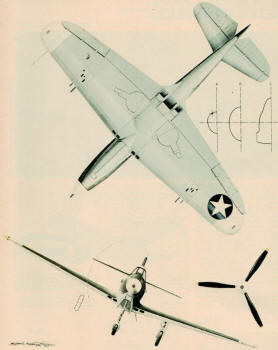
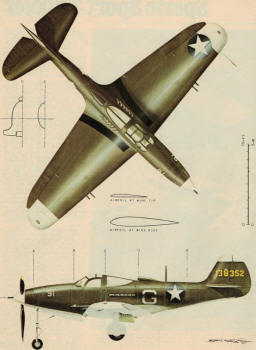
<click for larger version>
Notice:
The AMA Plans Service offers a
full-size version of many of the plans show here at a very reasonable cost. They
will scale the plans any size for you. It is always best to buy printed plans because
my scanner versions often have distortions that can cause parts to fit poorly. Purchasing
plans also help to support the operation of the
Academy of Model Aeronautics - the #1
advocate for model aviation throughout the world. If the AMA no longer has this
plan on file, I will be glad to send you my higher resolution version.
Try my Scale Calculator for
Model Airplane Plans.
Björn Karlström Drawings:
Posted November 12, 2010
|




